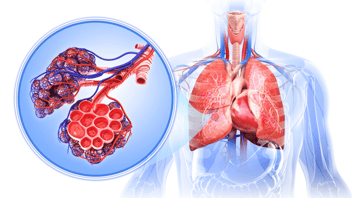COPD (Chronic Obstructive Pulmonary Disease) NCLEX Review for Nursing Students
%20nclex%20review%20nursing%20students.png)
Understanding Chronic Obstructive Pulmonary Disease (COPD)
Is important for nursing students preparing for the NCLEX exam due to several reasons:
Prevalence and Impact: COPD is a widespread chronic respiratory condition that significantly affects patients' quality of life. Nurses are likely to encounter patients with COPD in various healthcare settings.
Complexity of the Disease: COPD involves multiple components, including chronic bronchitis and emphysema, which can present differently in patients. Nurses need to understand the various manifestations and treatment approaches.
Struggling to keep up in class?
The Nursing School Survival Package gives you a daily plan, visual cheatsheets, and everything you need to stop falling behind.
👉 Get the system that actually works →
Progressive Nature: COPD is a progressive disease with exacerbations and remissions. Nurses should be able to identify signs of exacerbation and intervene to prevent further deterioration.
Respiratory Assessment: COPD patients often have impaired gas exchange, breathlessness, and increased respiratory effort. Nurses should be skilled in assessing these aspects accurately.
Oxygen Therapy: Nurses need to understand the appropriate use of oxygen therapy, as COPD patients can be sensitive to high oxygen levels, which might suppress their respiratory drive.
Medication Management: Nurses should be familiar with medications used to manage COPD, including bronchodilators, corticosteroids, and mucolytics, along with their administration routes and potential side effects.
Self-Management: COPD requires self-management strategies, including inhaler techniques, breathing exercises, and recognizing early signs of exacerbation. Nurses play a role in educating patients about these strategies.
Nutrition and Hydration: COPD patients may have difficulties eating and staying hydrated due to breathlessness. Nurses should assess nutritional status and offer guidance on maintaining adequate intake.
Pulmonary Rehabilitation: Nurses should understand the benefits of pulmonary rehabilitation programs and the role they play in improving exercise tolerance and overall quality of life for COPD patients.
Smoking Cessation: Smoking is a major risk factor for COPD. Nurses should be skilled in providing motivational support and resources for smoking cessation.
End-of-Life Care: In advanced stages, COPD can lead to end-of-life decisions. Nurses should be prepared to address advanced care planning and palliative care needs.
NCLEX Preparation: The NCLEX exam may include questions related to COPD, its pathophysiology, management, and complications. A strong understanding of this topic is crucial for answering these questions accurately.
%20nclex%20prep.png?width=740&height=416&name=COPD%20(Chronic%20Obstructive%20Pulmonary%20Disease)%20nclex%20prep.png)
Overall, understanding COPD equips nursing students to provide safe, patient-centered care to individuals with this chronic condition. It ensures that nursing students are prepared to address the unique challenges and needs of COPD patients and contribute to positive patient outcomes.
Overview of COPD (Chronic Obstructive Pulmonary Disease)
Chronic obstruction of airflow due to emphysema and chronic bronchitis
General Information for COPD (Chronic Obstructive Pulmonary Disease):
1. Emphysema
a. Destruction of alveoli due to chronic inflammation
b. Decreased surface area for gas exchange
2. Chronic Bronchitis
a. Chronic airway inflammation with productive cough
b. Excessive sputum production
Assessment for COPD (Chronic Obstructive Pulmonary Disease)
1. Barrel chest
a. Expanded rib cage due to increased work when breathing and air trapping
2. Accessory muscle use
3. Adventitious breath sounds
a. Diminished
b. Crackles
c. Wheezes
4. Congestion on Chest X-ray
5. ABG → ↓ pH, ↑ pCO2, ↓ PaO2
Therapeutic Management for COPD (Chronic Obstructive Pulmonary Disease)
1. Do NOT give O2 > 2 Lpm
a. A stimulus to breathe = ↓ O2
2. Chest Physiotherapy (CPT)
a. Loosen secretions
3. Increase fluid intake (3 L / day) → Thin
secretions
4. Medications→ Bronchodilators, corticosteroids
Struggling to keep up in class?
The Nursing School Survival Package gives you a daily plan, visual cheatsheets, and everything you need to stop falling behind.
👉 Get the system that actually works →
Nursing Case Study for COPD (Chronic Obstructive Pulmonary Disease)
Patient Profile:
Robert Johnson, a 75-year-old man, presents to the primary care clinic with complaints of worsening shortness of breath, chronic cough, and increased sputum production. He has a history of smoking for over 40 years.
Assessment:
Upon assessment, Robert appears fatigued and uses accessory muscles to breathe. His respiratory rate is elevated, and he has audible wheezing upon auscultation. He reports decreased exercise tolerance and difficulty performing activities of daily living.
Interventions:
1. Respiratory Assessment:
Conduct a comprehensive respiratory assessment, including lung sounds, chest expansion, and oxygen saturation.
2. Oxygen Therapy:
Administer supplemental oxygen as needed to maintain oxygen saturation within the target range.
3. Bronchodilator Administration:
Administer bronchodilators as prescribed to help open airways and relieve bronchoconstriction.
4. Breathing Techniques:
Teach Robert pursed-lip breathing and diaphragmatic breathing to help improve his lung function and reduce breathlessness.
5. Pulmonary Rehabilitation Referral:
Collaborate with the healthcare provider to refer Robert to a pulmonary rehabilitation program to enhance his exercise tolerance and quality of life.
6. Smoking Cessation Counseling:
Provide counseling and resources to support Robert's efforts to quit smoking, which is crucial in managing COPD.
7. Medication Review:
Review Robert's medications, including inhalers, to ensure he understands how to use them correctly.
8. Nutritional Support:
Assess Robert's nutritional status and offer guidance on maintaining a balanced diet to support his energy needs.
9. Hydration:
Encourage Robert to stay hydrated, as dehydration can thicken mucus and worsen breathlessness.
10. Education:
Educate Robert about COPD, triggers that exacerbate symptoms, and when to seek medical attention.
11. End-of-Life Discussion:
Initiate a conversation about advanced care planning and end-of-life preferences to ensure Robert's wishes are respected.
Outcome:
With consistent adherence to treatment and lifestyle modifications, Robert's shortness of breath and wheezing gradually improve. He successfully completes a pulmonary rehabilitation program, which enhances his exercise capacity and empowers him to manage his condition more effectively. Robert is motivated to quit smoking and seeks support to address his addiction. He develops a comprehensive COPD management plan and is able to better participate in activities he enjoys.
Struggling to keep up in class?
The Nursing School Survival Package gives you a daily plan, visual cheatsheets, and everything you need to stop falling behind.
👉 Get the system that actually works →
You CAN Do This
Happy Nursing!






%20nclex%20review%20nursing%20students.png?width=352&name=Tuberculosis%20(TB)%20nclex%20review%20nursing%20students.png)